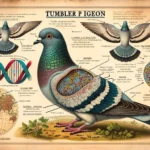Key Takeaways
- Pigeons possess remarkable orientation abilities during migration, allowing them to navigate over long distances.
- They primarily rely on various sensory cues, including landmarks, the Earth’s magnetic field, and celestial bodies, to guide their flight.
- Research suggests that pigeons have the ability to form cognitive maps of their surroundings and use them to navigate accurately.
Sensory Cues Used by Pigeons for Orientation
Pigeons have long been known for their exceptional orientation abilities during migration. They can travel vast distances and return to their home loft without getting lost. This remarkable skill is attributed to their ability to use various sensory cues to navigate accurately. Some of the sensory cues that pigeons rely on for orientation include:
- Landmarks: Pigeons have a keen sense of visual recognition and can memorize landmarks along their migration route. They use these landmarks to navigate and find their way back to their home loft.
- Earth’s Magnetic Field: Pigeons have a specialized iron-rich area in their beaks that allows them to detect the Earth’s magnetic field. This ability helps them determine their orientation and navigate in the right direction.
- Celestial Bodies: Pigeons can use the position of celestial bodies, such as the sun, moon, and stars, to orient themselves during migration. They have been observed to adjust their flight direction based on the position of these celestial bodies relative to their flight path.
By integrating these sensory cues, pigeons are able to navigate accurately and find their way during migration.
The Cognitive Map Theory in Pigeon Migration
One widely accepted theory that explains pigeons’ remarkable orientation abilities during migration is the cognitive map theory. According to this theory, pigeons are capable of forming mental maps of their surroundings and use these maps to navigate effectively.
The cognitive map is believed to be a mental representation of the landscape or environment that pigeons create based on their previous experiences and visual cues. It allows them to recognize and remember landmarks along their migration route, which they use as reference points to orient themselves.
Studies have shown that when pigeons are displaced from their familiar surroundings, they can still navigate accurately to their destination. This suggests that they possess an internal cognitive map that guides their flight.
Additionally, experiments involving altering the visual cues or landmarks in the environment have demonstrated that pigeons can update their cognitive maps and adjust their flight path accordingly. This further supports the idea that pigeons rely on cognitive maps for orientation during migration.
Ongoing Research and Future Directions
Research on pigeons’ orientation during migration is still ongoing, and scientists continue to explore the complex mechanisms behind their navigation abilities. Some current areas of research include:
- Investigating the role of specific genes and proteins involved in pigeons’ magnetoreception and orientation abilities.
- Studying the influence of different environmental factors, such as weather conditions and atmospheric changes, on pigeons’ navigation abilities.
- Examining the neural pathways and mechanisms in the pigeon brain that are responsible for processing sensory cues and forming cognitive maps.
By further understanding the intricacies of pigeon migration and orientation, scientists hope to gain valuable insights into both avian navigation and human spatial cognition.









